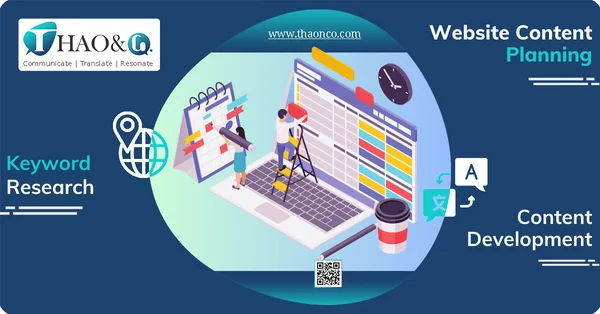Planning your website content had you in a creative chokehold? You’re not alone. Unplanned content is like a jigsaw puzzle with missing pieces – confusing, incomplete, and unlikely to reflect your brand’s full potential. It leaves you vulnerable to competitors and invisible to the very audience that you seek to engage.
With website content planning for SEO, you’re not just building pages. You’re constructing a digital ecosystem where each and every element serves a purpose, aligning with your business objectives, nourishing your audience, and delighting search engines.
In this article, we’ll let you in on the content development secrets that our SEO strategists at Thao & Co. swear by. You’ll learn the best practices for conducting keyword research, organizing information architecture, mapping content to buyer journeys, developing practical calendars, and more. So, let’s get planning!
Planning website content is the strategic process of researching, organizing, and scheduling the creation of website content. This means you need to define your overarching content goals, conduct keyword research, structure your site content into logical topic pillars and clusters, and develop schedules for content production and publication.

In other words, website content planning is like building a strategic roadmap to brand success. Here’s how it can help:
All things considered, website content planning gives structure and purpose for your content creation. It helps your website engage with niche audiences and achieve specific business goals.
Any SEO expert worth their dime will tell you that keyword research lays the foundation for effective content strategy. In this stage, you figure out which search terms and topic areas hold the most potential value for your goals.
Like everything else, you need the right tools for the job. Popular keyword research tools such as Ahref and SEMrush can help you identify relevant keywords, gauge their search volume, and assess competition. Don’t forget about free alternatives like Google Search Console and Google Trends!
Wonder how to kick off your research? The best way is to start with a few core keywords related to your niche and audience. These will guide your research and help you uncover additional keyword variations, related terms and ideas within related themes.
Don’t just look at search volume – it’s not all about the bling. Analyze keyword difficulty, competition, and user intent to assess which keywords are worthwhile targets. A high-volume keyword may be tempting, but if it’s been already claimed by a bunch of major players, you’ll probably be better off focusing on smaller, more attainable keywords.
So, you’ve got the basics. But keyword research does get a lot more complex. If you need more specifics on conducting keyword research for your website, check out our comprehensive step-by-step keyword research guide where you can learn about keyword tools, advanced keyword analysis techniques, and best practices to make the most out of your keyword research.
Your keyword research has yielded dozens or even hundreds of terms. Now what? At Thao & Co., we believe in organization. The best practice to bring order to your keyword chaos is structuring your website into logical content pillars and clusters to group related keywords and themes.
What exactly are content pillars? Think of them as your big-picture themes, the overarching concepts that resonate with your target audience and tie together your mountain of keywords. These pillars are comprehensive pages that broadly cover a topic and link to cluster content – more specific articles or pages that delve into particular topics in detail. For example, an e-commerce company can have product-based pillars, while a healthcare website can organize their content by health conditions.
This kind of structure helps your audience navigate your content and understand the relationship between different pieces of content. No more Frankenstein-ing your content! Pillar-based organization creates a natural flow and a smooth user experience. Moreover, it also helps with search engine optimization. By interlinking related pages, you let search engines know the semantic relationship between content, which enhances your website’s authority on the subject and improves search rankings.

Content pillars are the cornerstones of your expertise – the broad themes within your niche where you truly shine. There are several types of common content pillars:
To determine which content pillars will work well for your website, you’ll need a strategic evaluation of your brand’s key offerings, audience needs, and market position. You can start by:
By doing so, you can establish content pillars that are relevant and aligned with your audience’s interests and your business goals.
Content pillars are your foundation, but alone they aren’t enough. You need topic clusters to drill down into specific subtopics, allowing very targeted content creation and optimization.
For example, if your business sells Smart Home Devices, you could have an overview Smart Home Devices landing page with your product lineup and categories. This pools all related search traffic into one pillar page. Then, you could have product-specific cluster pages such as Smart Lighting, Smart Speakers and Assistants, and Smart Appliances, etc. These cluster pages offer much more precise content around individual niche topics and related keywords.
Now that you have your content pillars and topic clusters, it’s time to consider how they all fit together. When organizing your website content architecture, how pillars and clusters interconnect is crucial. Being strategic with your content planning enhances intuitive internal linking.
To ensure your users have a seamless experience, the relationship between content pillars and clusters must be meticulously planned with a logical flow and internal linking. Consider your site from a user’s perspective. Each click should feel like a natural progression, leading them deeper into your expertise. Here’s how you can do that:
By ensuring that each piece of content logically connects to others within its cluster and back to its pillar page, you create a cohesive narrative that enhances the user experience and strengthens your website’s authority in the critical eye of search engines.
It’s nice to have a wide variety of content for your audience to pick and choose. But if you’re building your website from scratch, it’s important that you have priorities. That way, your content team isn’t overwhelmed and you will still have content that attracts traffic and satisfies user needs. At Thao & Co., when deciding which content pillars and topic clusters take the front seat, we consider:
Planning your website content isn’t just about doing everything in your power to get the top ranks on search engines. It’s crucial to balance SEO value with helpful content that truly meets the needs of your audience, resulting in a positive user experience and higher engagement.

Effective website content planning requires not just figuring out what kind of content to create but also when and how it should be rolled out. With your website content architecture mapped out into pillars, clusters, and pages, the next thing to do is developing realistic production and publishing schedules.
An editorial calendar is your best friend. It’s a strategic tool that helps you manage your content lifecycle from idea to publication. It ensures that your content creation aligns with your marketing goals, seasonal trends, and industry events. At Thao & Co., when developing an editorial calendar, we take into consideration:
Your website content isn’t once and done. It needs to be updated constantly and strategically to stay competitive. Here’s how you can plan and schedule new content additions:
Like fresh paint, your website content needs the occasional refreshes to maintain its vibrancy and SEO effectiveness. Maintaining and updating available content is just as crucial as creating new content. You can manage updates with:
Strategic website content planning is invaluable for your brand rankings on search engines and ultimately, your business growth. However, crafting and managing content plans takes considerable expertise and effort. It can feel especially overwhelming for businesses without a dedicated content team.

Thao & Co. is here to make SEO content planning smooth and stress-free for you. Our team specializes in:
Upon request, we also offer:
The next stage of your website awaits. Contact us on our Get a Quote page to evaluate your current website and explore how our content solutions can optimize organic growth.